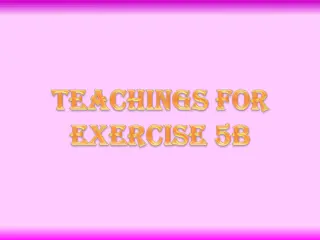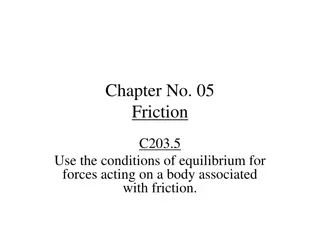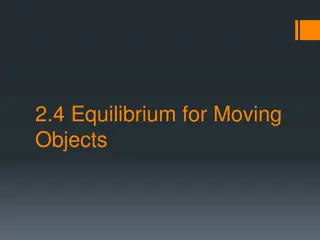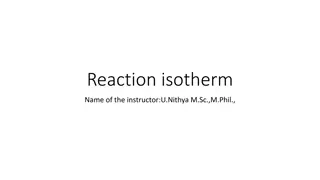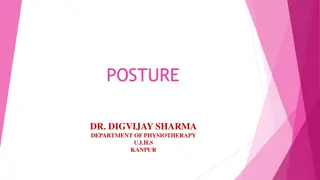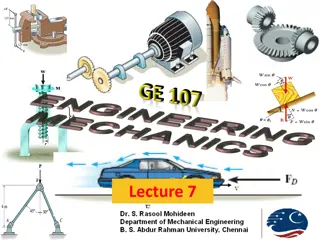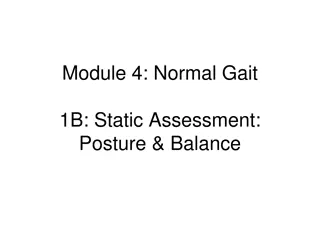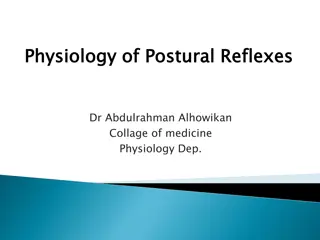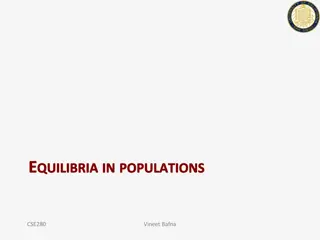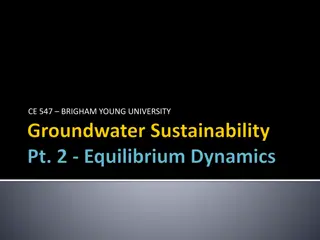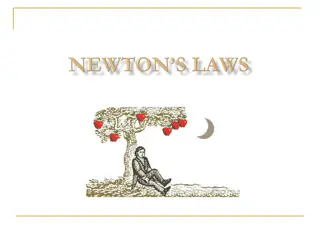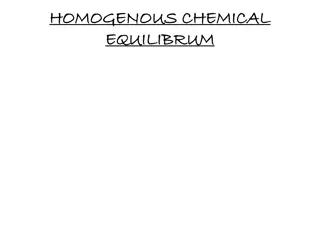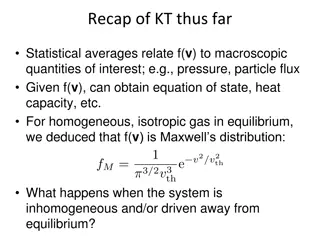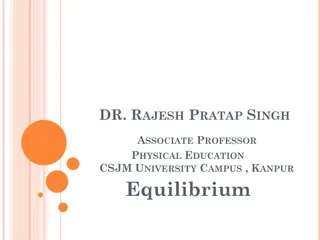Understanding Posture and Equilibrium
Posture is the maintenance of an upright position against gravity, involving anti-gravity muscles and postural reflexes. It depends on factors like muscletone, pathways in the central nervous system, and sensory receptors. Postural reflexes are crucial for maintaining balance and coordinating movements, involving various receptors and proprioceptors like neck proprioceptors, body proprioceptors, and pressure receptors. These reflexes can be modified by coordinated activity between different parts of the brain. Postural reflexes can be categorized as static reflexes (at rest) and phasic reflexes (with motion).
Download Presentation

Please find below an Image/Link to download the presentation.
The content on the website is provided AS IS for your information and personal use only. It may not be sold, licensed, or shared on other websites without obtaining consent from the author. Download presentation by click this link. If you encounter any issues during the download, it is possible that the publisher has removed the file from their server.
E N D
Presentation Transcript
POSTURE&EQUILIBRIUM Q-Whatisposture? Itismaintenanceofuprightpositionagainst gravity(centerofbodyisneededtobebetweenthe legs)itneedsantigarvitymuscles
1-Up-rightpostureneedposturalreflexes 2-posturedependsonmuscletone( stretchreflex)(basicposturalreflex) 3-Themainpathwaysconcernedwith postureare:- A-medialtractscontrolproximallimbs& axialmusclesforposture&gross movements 4-lateralpathwaysascorticospinal rubrospinal)controldistallimbs.
posturalreflexsdependsonthefollowing receptors:- 1-vestibularapparatusreceptorsas Maculae(utricle&saccule)&SCCcristea. -Maculaeforlinearacceleration&orientationof headinspace -SCCcristeaforangularacceleration 2-visual(vision)&auditory(hearing)receptors:- Visioncancompensateforlossofauditory, vestibular&proprioception -(Tabesdorsalis+veRombergism) -IfPtwithsensoryataxiastandswitheyesclosed,he falls down) 3-Proprioceptorsofmuscles,tendons,ligaments& joints:-
a-NeckProprioceptors:- detectheadpositioninrelationtotrunk b-BodyProprioceptorsproprioceptorsof anti-gravitymuscles c-pressurereceptorsasinsoleoffeet initiatepositivesupportingreaction( magnetreflex)
-Stretchreflexes&posturalreflexescanbe modifiedbycoordinatedactivity;- cerebellum Spinalcord Medulla Midbrain Cerebralcortex
Postural reflexes are:- A-Static reflexes( at rest) B-Phasic reflexes ( with motion)
A-StaticR:- (statotonic):-maintainpostureat rest:- A-spinal B-medullaryreflexes C-Rightingreflexes(midbrain) A-Spinalreflexes:-(CenterinS.C) 1-localstaticreflexes: Positivesupportingreaction(magnetreflex) (receptorsareproprioceptorsofflexors(contraction ofbothflexors&extensors) -protectivereflex 2-Stretchreflex
3-Segmental staticreflexes:- mediatedbyonesegmentofthespinalcordas:- a-Crossedextensorreflex b-NegativesupportingR(whichrelease+ve supportingreaction -(receptorsareproprioceptorsof extensorsofthereleasedlimb) N.BspinalRcanbestudiedinspinal animalwithcut atneckb/wtheS.C&brainstemsoallS.Cisintact.
- B-Medullary staticReflexes (Center=medullaoblongata)are:- Neck&labyrinthinereflexes 1-Neckstaticreflexes(studiedina decerebratedanimalcutabovemedulla+ labyrinthdestroyed) -Stimulusis:-changingheadpositionthat (+)neckproprioceptors
1--ventroflexionofhead / armsflexion+extendhindlimb( asindecortication). 2-dorsiflexionofhead/ armsextended+flexhindlimb. 3--turningheadtooneside Extentionoflimbsonthatside+ flexionofotherside.(asin decortication)
2-labyrinthinestaticreflex:-(in decerebratedanimal)+eliminationof neckproprioceptors)(labyrinthintact) -Receptorsareotolithorgans(maculae) -Stimulusisgravity 1-ventroflexionofhead(orprone position)-----4limbsflexion 2-dorsiflexionofhead(orsupine position)-----4limbsextended(asin decerebration)
C-Rightingreflexes:- (Centerismidbrainexceptthe visualinC.C):- whenuprightpostureisdisturbedasinfalling down -studiedinadecerebratedanimal(cutabove midbrain=upperdecerebration) a-visualrightingreflexes( cortical):- -Visualimagecancorrectpositionofhead& bodyifpositionisdisturbed -centerisc.c- -stim:visualstim -receptors;eyereceptors
b-labyrinthinerightingreflexes (midbrain):- (covereyes)&animalheldinairfrom pelvis) -thebodyisnotintheproperposition Asintiltingthehead(+)otolithorgans- >>>>-(+)neckmusclestocorrectthehead level,whenheadisnotinpropersite. receptors;otolithorgans, response;rightingofhead
All static labirynthine reflexes have macula as receptors (macula act in linear & SCC receptors act in angular acceleration) but in statokinetic reflexes during motion SCC receptors.
c-Bodyonheadrightingreflexes(midbrain):- :- Stim:pressureonsideofbody&headisfree receptors;trunkproprieoceptors Response/reflexcorrectionofhead. d-Bodyonbody(midbrain):- Pressureonsideofthebodyandheadisfixed) Receptors/trunkproprieoceptors response/reflexcorrectionofbody
e-Neckrightingreflexes(midbrain) :- stim:stretchofneckmuscles (Asifheadiscorrected&bodystilltilted receptors;musclespindlesofneck muscles response;-rightingofshoulders&then rightingofbody.
B-Phasicreflexes(statokineticreflexes)( centerinC.C):- -maintainpostureduringmotion a-Hoppingreaction:- -whenanimalispushedlaterally}}}}}reflexhoppingto keeplimbsinpositiontosupportbody. Thereceptorsareinmusclespindles. b-Placingreaction:- -blindfoldedanimalsuspendedinair&movedtowardsa supportingsurface,thefeetswillbeplacedfirmlyonthe supportingsurface(receptorsaretouchreceptors& proprioceptorsinsolesoffeet)
Decerebraterigidity :- -Insectionbetweensuperior&inferiorcolliculiofmidbrain (belowthelevelofthered nucleus(e.g.mid-collicularlesion)>>>>blocknormal inhibitorysignalsfrombrain&rednucleusinmidbrainto tonically active pontilereticularformation&Vestibular.Ncausing: 1-Maintainedtonicstaticposturalreflexesthatsupport animalagainstgravity:- a-medullarytonicneck b-medullarylabyrinthineR). 2-AbsentmidbrainrightingR 3-Extensionofhead&4limbsextensors(asin labyrinthinestaticR) -Thejawmaybeclenchedwiththeneckhyperextended duetoincreasedextensortonefromvestibulospinal& reticulospinaltractstoextensormotorneurons 4-spasticity&rigidity&extensioninantigravitymuscles -InhumanbyvascularlesionofbrainstembetweenredN&vestibularnucleus
Decorticaterigiditymorecommoninhumanthan decerebaterigidity:- 1-lesionincerebralcortexbutbrainstemisintact aswhatseeninhemiplegicptsafterHgeof internalcapsule 2-Medullarytonicneck&toniclabyrinthine reflexespresent 3-Rightingmidbrainreflexespresent 4-Visualrighting,placing&hoppingreflexeslost
5-itcausesextensorrigidityinlegs&moderateflexionof armsifheadunturned,assupineposition(tonicneck reflexes) - the hands are clenched into fists, and the legs extended and feet turned inward 2-Turningtheheadtoonesideinitiatestonicneckreflexes e.gturningheadtotheleft>>>>>>>extensionoflimbson leftside&flexionofrightside Cause:- 1-lesionsabovetherednucleussorubrospinalareintacttogetherwithpontine reticulospinalandthevestibulospinalleadstothecharacteristicflexionposturingofthe upperextremitiesandextensorposturingofthelowerextremities. 2-Sincethecorticospinaltractisinterrupted,thepontinereticulospinalandthe vestibulospinalextendL.L 3-normallysuppressorarea4stripintheanterioredgeofprecentralgyrusinhibitred nucleus,ifthisinhibitionislostbydecortication,rednucleusisdisinhibited, disinhibitionofthered nucleusfacilitatetherubrospinal tracttoflexU.L 4-Also/thereislossofinhibitorycorticalsignals(fromsuppressorarea4stripinthe anterioredgeofprecentralgyrus)togammamotorneuronsviareticulospinal
Thank you for listening


